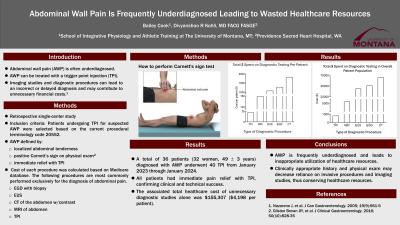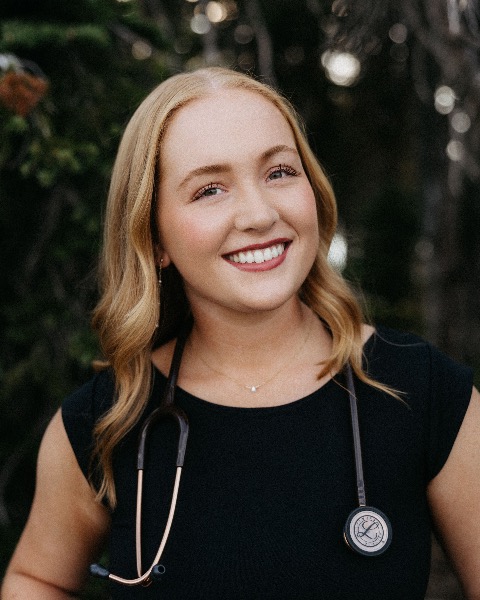Sunday Poster Session
Category: Functional Bowel Disease
P0639 - Abdominal Wall Pain Is Frequently Underdiagnosed Leading to Wasted Healthcare Resources
Sunday, October 27, 2024
3:30 PM - 7:00 PM ET
Location: Exhibit Hall E

Has Audio

Bailey N. Cook
School of Integrative Physiology and Athletic Training, University of Montana
Missoula, MT
Presenting Author(s)
Bailey N. Cook, 1, Divyanshoo Kohli, MD, FACG2
1School of Integrative Physiology and Athletic Training, University of Montana, Missoula, MT; 2Providence Sacred Heart Hospital, Spokane, WA
Introduction: Abdominal wall pain (AWP) can be diagnosed solely based on history and a focused physical exam. However, current clinical practices rely heavily on imaging studies and invasive procedures which can lead to incorrect or delayed diagnosis. We assessed the clinical and financial implications of inappropriate testing for diagnosing AWP.
Methods: In this retrospective single-center study from a tertiary care hospital, patients undergoing trigger point injections (TPI) for suspected AWP were selected based on the current procedural terminology code 20552. AWP was defined by localized abdominal tenderness, a positive Carnett’s sign on exam, and immediate relief with TPI. Radiological or endoscopic studies performed exclusively for diagnostic workup of abdominal pain were recorded and associated healthcare costs were calculated using the Medicare database. The primary outcome was the frequency and costs of unnecessary radiological and endoscopic testing. A paired t-test was used to compare means and a P-value < 0.05 was considered statistically significant.
Results: A total of 37 patients (32 women, 49±3 years, table 1) diagnosed with AWP underwent 40 TPI from January 2023 through May 2024. All patients had immediate pain relief with TPI confirming clinical and technical success. Surgical scars were noted at the site of abdominal pain in 19 (50%) patients. Before being diagnosed with AWP, these 37 patients underwent 146 CT scans of the abdomen ($65,554), 46 upper endoscopies with biopsy (EGD; $45,862), 19 endoscopic ultrasounds (EUS; $38,551), and 69 evaluations in the emergency room and clinic before being referred for further workup by the Gastroenterology service. The frequency of diagnostic testing before and after TPI are as follows: EGDs with biopsies (88.8% vs. 0; P= < 0.001), EUS (50% vs. 3%; P< 0.01); CT abdomen (83.33% vs. 19.44%; P=< 0.0001); MRI of the abdomen (22.22% vs. 0%; P=0.009). The associated total healthcare cost of inappropriate diagnostic studies alone was $155,307 ($4,198 per patient).
Discussion: AWP is frequently under-diagnosed and leads to wastage of healthcare resources. Clinically appropriate history and physical exam may obviate reliance on invasive procedures and imaging studies, thus conserving healthcare resources.
Note: The table for this abstract can be viewed in the ePoster Gallery section of the ACG 2024 ePoster Site or in The American Journal of Gastroenterology's abstract supplement issue, both of which will be available starting October 27, 2024.
Disclosures:
Bailey N. Cook, 1, Divyanshoo Kohli, MD, FACG2. P0639 - Abdominal Wall Pain Is Frequently Underdiagnosed Leading to Wasted Healthcare Resources, ACG 2024 Annual Scientific Meeting Abstracts. Philadelphia, PA: American College of Gastroenterology.
1School of Integrative Physiology and Athletic Training, University of Montana, Missoula, MT; 2Providence Sacred Heart Hospital, Spokane, WA
Introduction: Abdominal wall pain (AWP) can be diagnosed solely based on history and a focused physical exam. However, current clinical practices rely heavily on imaging studies and invasive procedures which can lead to incorrect or delayed diagnosis. We assessed the clinical and financial implications of inappropriate testing for diagnosing AWP.
Methods: In this retrospective single-center study from a tertiary care hospital, patients undergoing trigger point injections (TPI) for suspected AWP were selected based on the current procedural terminology code 20552. AWP was defined by localized abdominal tenderness, a positive Carnett’s sign on exam, and immediate relief with TPI. Radiological or endoscopic studies performed exclusively for diagnostic workup of abdominal pain were recorded and associated healthcare costs were calculated using the Medicare database. The primary outcome was the frequency and costs of unnecessary radiological and endoscopic testing. A paired t-test was used to compare means and a P-value < 0.05 was considered statistically significant.
Results: A total of 37 patients (32 women, 49±3 years, table 1) diagnosed with AWP underwent 40 TPI from January 2023 through May 2024. All patients had immediate pain relief with TPI confirming clinical and technical success. Surgical scars were noted at the site of abdominal pain in 19 (50%) patients. Before being diagnosed with AWP, these 37 patients underwent 146 CT scans of the abdomen ($65,554), 46 upper endoscopies with biopsy (EGD; $45,862), 19 endoscopic ultrasounds (EUS; $38,551), and 69 evaluations in the emergency room and clinic before being referred for further workup by the Gastroenterology service. The frequency of diagnostic testing before and after TPI are as follows: EGDs with biopsies (88.8% vs. 0; P= < 0.001), EUS (50% vs. 3%; P< 0.01); CT abdomen (83.33% vs. 19.44%; P=< 0.0001); MRI of the abdomen (22.22% vs. 0%; P=0.009). The associated total healthcare cost of inappropriate diagnostic studies alone was $155,307 ($4,198 per patient).
Discussion: AWP is frequently under-diagnosed and leads to wastage of healthcare resources. Clinically appropriate history and physical exam may obviate reliance on invasive procedures and imaging studies, thus conserving healthcare resources.
Note: The table for this abstract can be viewed in the ePoster Gallery section of the ACG 2024 ePoster Site or in The American Journal of Gastroenterology's abstract supplement issue, both of which will be available starting October 27, 2024.
Disclosures:
Bailey Cook indicated no relevant financial relationships.
Divyanshoo Kohli indicated no relevant financial relationships.
Bailey N. Cook, 1, Divyanshoo Kohli, MD, FACG2. P0639 - Abdominal Wall Pain Is Frequently Underdiagnosed Leading to Wasted Healthcare Resources, ACG 2024 Annual Scientific Meeting Abstracts. Philadelphia, PA: American College of Gastroenterology.
